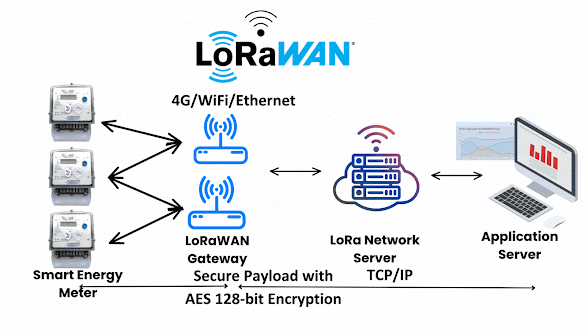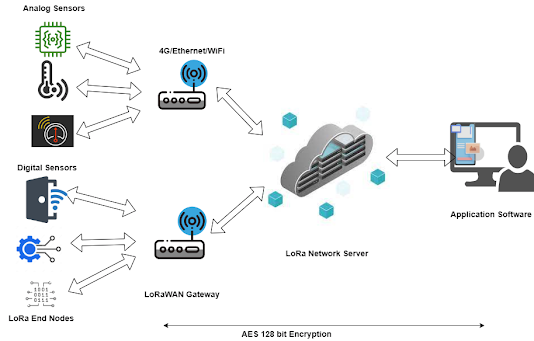As the world
advances towards a more sustainable future, the demand for efficient energy
management solutions has grown exponentially. In this quest for optimized
resource utilization, LoRaWAN® technology has emerged as a game-changer. LoRaWAN®-based
energy metering solutions are revolutionizing the way we measure, monitor, and
manage energy consumption. In this blog post, we will explore the potential of LoRaWAN®
in energy metering, along with the architecture that makes it all possible,
paving the way for a greener and more sustainable future.
Understanding
LoRaWAN® Architecture
LoRaWAN®, short
for Long Range Wide Area Network, is a wireless communication protocol designed
for low-power, long-range applications, making it ideal for energy metering.
The LoRaWAN® architecture consists of three fundamental components:
LoRa End Devices: These
are the smart energy meters deployed at various locations to measure energy
consumption. They use the LoRaWAN® protocol to transmit data wirelessly.
LoRaWAN® Gateways: Gateways
act as intermediaries between the end devices and the LoRaWAN® network server.
They receive data from the energy meters and forward it to the central server.
LoRa Network Server: The
network server acts as the backbone of the LoRaWAN® architecture. It manages
the entire communication process, including data encryption, authentication,
and device management.
Key Features of LoRaWAN®-based Smart Energy Metering Solutions
Reliable and Extended Range: LoRaWAN®'s long-range capabilities ensure seamless communication between energy meters and the central server, even over vast areas, such as residential complexes or industrial facilities. This eliminates the need for extensive infrastructure setup, making it cost-effective and scalable.
Low Power Consumption: Energy meters integrated with LoRaWAN® technology operate on ultra-low power. This significantly extends the battery life of the devices, reducing maintenance requirements and enhancing overall efficiency.
Secure Data Transmission: LoRaWAN® offers built-in security features, ensuring that sensitive energy consumption data remains safe during transmission. Advanced encryption and authentication mechanisms protect against unauthorized access and data breaches.
Easy Deployment and Integration: LoRaWAN®'s plug-and-play architecture allows for quick and straightforward installation of smart energy meters. Additionally, its compatibility with various applications and platforms makes integration into existing systems seamless.
LoRaWAN®-based Energy Metering in Action
· Real-time Energy Monitoring: LoRaWAN®-enabled energy meters provide real-time insights into energy consumption patterns. This empowers consumers and businesses to track their usage, identify inefficiencies, and make data-driven decisions to optimize energy consumption.
Remote Data Collection: With LoRaWAN®, energy meter readings can be collected remotely without the need for physical access. This not only saves time and resources but also reduces the carbon footprint associated with manual data collection.
· Billing Accuracy: LoRaWAN®-based energy
metering ensures accurate and tamper-proof data, eliminating the risk of human
errors and potential fraudulent activities. This leads to fair and transparent
billing for consumers and increased revenue protection for utility providers.
· Demand Response and Load Management: By
analyzing real-time energy consumption data, utilities can implement demand
response strategies and load management techniques. This allows them to balance
the energy grid during peak demand, reducing strain and avoiding potential
blackouts.
Conclusion
The integration
of LoRaWAN® technology into energy metering solutions, coupled with its robust
architecture, marks a significant milestone in the pursuit of energy efficiency
and sustainability. By enabling real-time monitoring, accurate billing, and
demand response capabilities, LoRaWAN® empowers consumers and utility providers
alike to make informed decisions for a greener future. As the world continues
to embrace IoT and smart technologies, LoRaWAN®-based energy metering is set to
play a crucial role in transforming the energy landscape and creating a more
sustainable and energy-conscious society.






